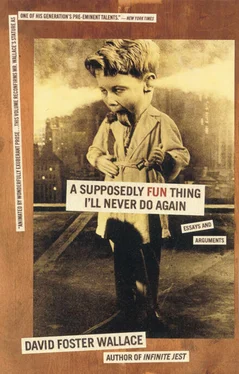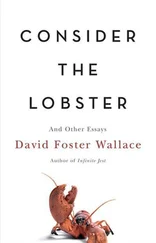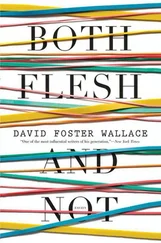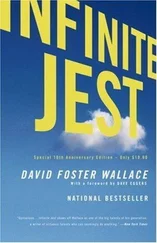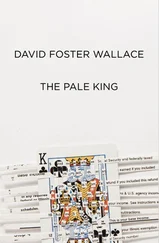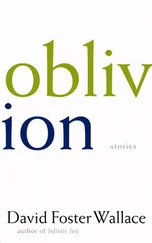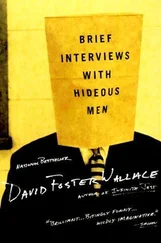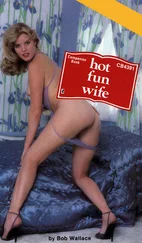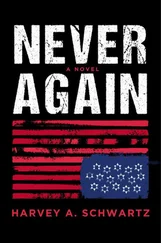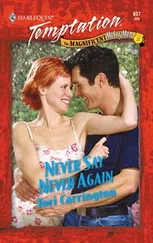It’s 1:30 P.M. Joyce has broken Brakus’s serve once and is up 3–1 in the first set and is receiving. Brakus is in the multibrand clothes of somebody without an endorsement contract. He’s well over six feet tall, and like many large male collegians his game is built around his serve. 22At 0–15, his first serve is flat and 118 mph and way out to Joyce’s backhand, which is a two-hander and hard to lunge effectively with, but Joyce lunges plenty effectively and sends the ball back down the line to the Canadian’s forehand, deep in the court and with such flat pace that Brakus has to stutter-step a little and backpedal to get set up — clearly he’s used to playing guys for whom 118 mumps out wide would be an outright ace or at least produce such a weak return that he could move up easily and put the ball away — and Brakus now sends the ball back up the line high over the net, loopy with topspin, not all that bad a shot considering the fierceness of the return, and a topspin shot that’d back most tennis players up and put them on the defensive, and but Michael Joyce, whose level of tennis is such that he moves in on balls hit with topspin and hits them on the rise, 23moves in and takes the ball on the rise and hits a backhand cross so tightly angled that nobody alive could get to it. This is kind of a typical Joyce-Brakus point. The match is carnage of a particular high-level sort: it’s like watching an extremely large and powerful predator get torn to pieces by an even larger and more powerful predator. Brakus looks pissed off after Joyce’s winner, makes some berating-himself-type noises, but the anger seems kind of pro forma: it’s not like there’s anything Brakus could have done much better, not given what he and the 79th-best player in the world have in their respective arsenals.
Michael Joyce — whose realness and approachability and candor are a big reason why he’s whom I end up spending the most time watching and talking to — will later say, in response to my dry observation that a rather disproportionate number of unranked Canadians seem to have gotten wild cards into the Montreal Qualies, that Brakus “had a big serve, but the guy didn’t belong on a pro court.” Joyce didn’t mean this in an unkind way. Nor did he mean it in a kind way. It turns out that what Michael Joyce says rarely has any kind of spin or slant on it; he mostly just reports what he sees, rather like a camera. You couldn’t even call him sincere, because it’s not like it seems ever to occur to him to try to be sincere or nonsincere. For a while I thought that Joyce’s rather bland candor was a function of his not being very bright. This judgment was partly informed by the fact that Joyce didn’t go to college and was only marginally involved in his high school academics (stuff I know because he told me it right away). 24What I discovered as the tournament wore on was that I can be kind of a snob and an asshole, and that Michael Joyce’s affectless openness is a sign not of stupidity but of something else.
Advances in racquet technology and conditioning methods over the last decade have dramatically altered men’s professional tennis. For much of the twentieth century, there were two basic styles of top-level play. The “offensive” 25style is based on the serve and the net game and is ideally suited to slick (or “fast”) surfaces like grass and cement. The “defensive” or “baseline” style is built around foot-speed, consistency, and groundstrokes accurate enough to hit effective passing shots against a serve-and-volleyer; this style is most effective on “slow” surfaces like clay and Har-Tru composite. John McEnroe and Bjorn Borg are probably the modern era’s greatest exponents of the offensive and defensive styles, respectively.
There is now a third way to play, and it tends to be called the “power-baseline” style. As far as I can determine, Jimmy Connors 26more or less invented the power-baseline game back in the ’70s, and in the ’80s Ivan Lendl raised it to a kind of brutal art. In the ’90s, the majority of young players on the ATP Tour now have a P.B.-type game. This game’s cornerstone is groundstrokes, but groundstrokes hit with incredible pace, such that winners from the baseline are not unusual. 27A power-baseliner’s net game tends to be solid but uninspired — a P.B.er is more apt to hit a winner on the approach shot and not need to volley at all. His serve is competent and reasonably forceful, but the really inspired part of a P.B.er’s game is usually his return of serve. 28He usually has incredible reflexes and can hit winners right off the return. The P.B.er’s game requires both the power and aggression of an offensive style and the speed and calculated patience of a defensive style. It is adjustable both to slick grass and to slow clay, but its most congenial surface is DecoTurf, 29the type of slow abrasive hard-court surface now used at the U.S. Open and at all the broiling North American tournaments leading up to it, including the Canadian Open.
Boris Becker and Stefan Edberg are contemporary examples of the classic offensive style. Serve-and-volleyers are often tall, 30and tall Americans like Pete Sampras and Todd Martin and David Wheaton are also offensive players. Michael Chang is an exponent of the pure defensive style, as are Mats Wilander, Carlos Costa, and a lot of the Tour’s Western Europeans and South Americans, many of whom grew up exclusively on clay and now stick primarily to the overseas clay-court circuits. Americans Jim Courier, Jimmy Arias, and Aaron Krickstein all play a power-baseline game. So does just about every young new male player on the Tour. But the style’s most famous and effective post-Lendl avatar is Andre Agassi, who on 1995’s summer circuit is simply kicking everyone’s ass. 31
Michael Joyce’s style is power-baseline in the Agassi mold: Joyce is short and right-handed and has a two-handed backhand, a serve that’s just good enough to set up the baseline attack, and a great return of serve that’s the linchpin of his game. Like Agassi, Joyce takes the ball early, on the rise, so it always looks like he’s moving forward in the court even though he rarely comes to net. Joyce’s first serve usually comes in around 95 mph, 32and his second serve is in the low 80s, but it has so much spin on it that the ball turns weird shapes in the air and bounces high and wide to the first-round Canadian’s backhand. Brakus stretches for the ball and floats a slice return, the sort of weak return that a serve-and-volleyer’d be rushing up to the net to put away on the fly. Joyce does move up, but only to midcourt, right around his own service line, where he lets the floater land and bounce up all ripe, and he winds up his forehand and hits a winner crosscourt into the deuce corner, very flat and hard, so that the ball makes an emphatic sound as it hits the scarlet tarp behind Brakus’s end of the court. Ballboys move for the ball and reconfigure complexly as Joyce walks back to serve another point. The applause of the tiny crowd is so small and sad and shabby-sounding that it’d almost be better if people didn’t clap at all.
As with Lendl and Agassi and Courier and many P.B.ers, Joyce’s strongest shot is his forehand, a weapon of near-Wagnerian aggression and power. Joyce’s forehand is particularly lovely to watch. It’s more spare and textbook than Lendl’s whip-crack forehand or Borg’s great swooping loop; by way of decoration there’s only a small loop of flourish 33on the backswing. The stroke itself is completely horizontal, so Joyce can hit through the ball while it’s still well out in front of him. As with all great players, Joyce’s side is so emphatically to the net as the ball approaches that his posture is a classic contrapposto.
As Joyce on the forehand makes contact with the tennis ball, his left hand behind him opens up, as if he were releasing something, a decorative gesture that has nothing to do with the mechanics of the stroke. Michael Joyce doesn’t know that his left hand opens up at impact on forehands: it is unconscious, some aesthetic tic that started when he was a child and is now inextricably hardwired into a stroke that is itself unconscious for Joyce, now, at 22, after years of hitting more forehands over and over than anyone could ever count. 34
Читать дальше
